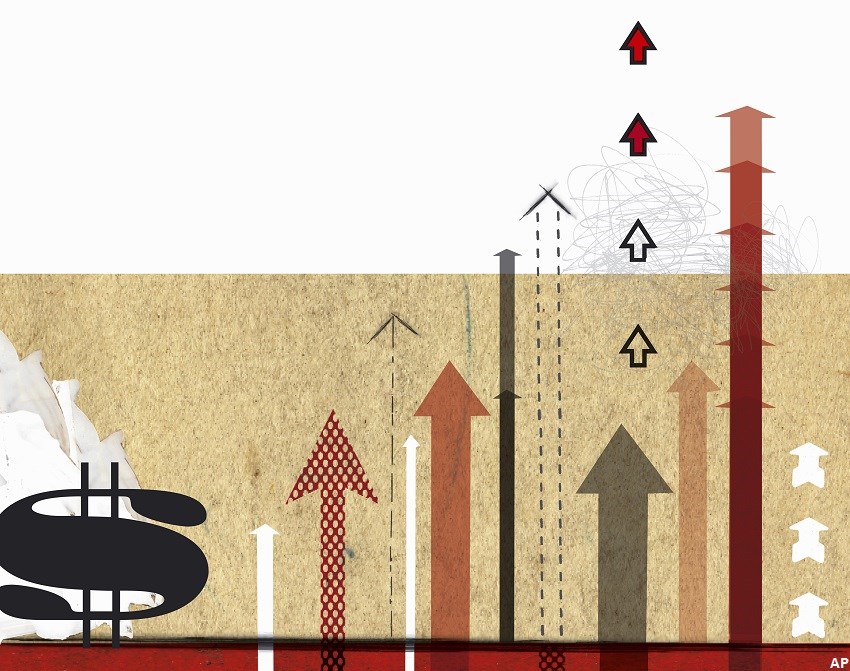
While the rate hikes are all part of the process of normalization following the COVID-19 pandemic, there are ways to profit from the central bank’s inflation-busting program, according to fixed income specialists Geof Marshall and Darren Arrowsmith.
Fixed income markets are in a tizzy because the Bank of Canada has raised its so-called policy rate to 1%, after one 25 basis points (bps) increase in March and a 50 bps increase in April. They’ve been followed with talk by Governor Tiff Macklem of possibly larger hikes to come, to quell inflation.
“What we are seeing here are the central banks getting back to a normalized rate environment, post-COVID. The central banks were already cutting rates before COVID, and after the last hiking cycle,” says Geof Marshall, head of high yield and senior vice-president at Toronto-based CI Investments, and co-manager of the $66.1 million 5-star neutral rated CI Floating Rate Income F.
“We had a lot of monetary and fiscal stimulus and right now we have some very large inflationary pressures and very low unemployment. We have about 200 bps, or 2 percentage points of interest rate hikes priced into the market, both here and in the U.S. To us, that seems over-done, more so in Canada than in the U.S. They are further behind the curve.”
Demand-Push Inflation is Next
Where interest rates end up in Canada, argues Marshall, depends on how inflation and economic growth respond to monetary policy. “Two things are in play. One is where we have a ‘base effect.’ That’s where inflation will fall based on a year-over-year comparison. Supply chain issues, in terms of lock-downs and how that affects prices, are what we call ‘cost-pull’ inflation. We’ve been dealing with that. But going forward it’s going to be ‘demand-push’ inflation.” Marshall observes that people are travelling again, going to restaurants, and spending more freely, which is contributing to inflationary pressures. But once that spending activity is over, and higher rates kick in, he maintains that inflation will gradually come down.
Base Case is Moderation
“I suspect that inflation will be more subdued in the second half of the year and central banks don’t have to be as aggressive as they were in the first half,” says Marshall, a 24-year industry veteran who joined CI in 2006. “It feels overdone at this point. Our base case is that inflation will be moderating.” In his view, the Bank of Canada will raise interest rates by 150 to 200 bps over the rest of the year.
CI Floating Rate Income Fund can benefit from rising rates, as the fund is largely invested in corporate loans. “Term loans are at the top of the corporate capital structure,” says Arrowsmith, vice-president, and a 21-year industry veteran and high-yield bond specialist who joined the firm in 2012 after working for GE Capital in London, UK, and Montreal-based Stanton Asset Management, where he assisted with the management of global high-yield bonds and leveraged loans.
Better Terms
Term loans often come with stronger covenants and creditor protection than other parts of the capital structure. “They re-set monthly or quarterly, based on short-term interest rates, which can provide income and price stability in a rising rate environment,” says Arrowsmith. “Floating rate loans are ideal for investors who want to diversify a portion of their credit-sensitive fixed income investments and potentially benefit from higher interest rates in a rate-hiking cycle.”
Year-to-date (April 26) the fund has returned -1.37%, versus -1.24% for the Floating Rate Loan category. Launched in June 2017, the fund returned 1.76% for the last 12 months, versus 1.31% for the category. For the last three years, the fund had an annualized return of 3.88%, versus 1.05% for the category. The fund has a running yield of 5%. On April 19, the product was launched as an exchange-traded fund, with the symbol, CFRT. It has a management fee of 35 bps.
Marshall points out that because it is a floating rate asset class that it is secured it has historically been more stable than, say, high-yield bonds, which are generally unsecured. “I see them as lower-beta, or less volatile, version of the high-yield bond space. They are particularly useful for investors who are worried about rising rates, or rising government yields. If an investor thinks that 5% of their portfolio should be in high-yield bonds they are just as well served by holding that 5% in floating rate loans, and get the same effect. They are really good insurance in today’s period when rates are rising.”
Recession Risks are a Reality
Still, investors must be aware of the risks involved, and in particular credit risks. “If, for instance, the Federal Reserve tightens financial conditions too much, then it’s possible that economic growth could contract or even precipitate a recession,” says Arrowsmith. “We are not expecting that in the near term. But it is something to be mindful of.” Typically, he adds, loans will outperform in a rising rate environment and can also outperform when the economy is in the late part of the cycle. “The secured nature of the asset class should help protect it on the downside due to higher-recovery values, in the event of default, if that were to happen,” he says, reiterating that while floating-rate loans exhibit less volatility than other types of corporate fixed income classes, there is still the risk of default, a factor that puts it on a similar footing to high-yield bonds.
The Strategy
From a strategic perspective, the portfolio consists of about 80 holdings and relies on a system of credit and security selection. “We view the holdings in three different categories,” says Arrowsmith, adding that he and Marshall are supported by three other portfolio managers and analysts. “There are core holdings, catalyst-driven situations where we have high convictions where the investment may be called or redeemed, and so-called ‘yield-to-call’ situations where we also have high convictions that given the fundamentals and technicals that the loans will either be redeemed or refinanced in the short term. The asset mix of all these categories together allows for better flexibility. It also promotes high active share versus the S&P/LSTA Leveraged Loan Index and it helps preserve capital.”
Lending to Cruises
One representative holding in the portfolio is a term loan from Carnival Corp. (CCL), a leading cruise provider. “Prior to COVID, we were not involved in the cruise operators. Their revenue went to zero, or close to it. And their credit ratings were downgraded in April 2020,” says Arrowsmith. “This generated some forced selling from investment-grade investors, some of whom cannot hold high-yield. When you get forced selling, you get fairly attractive entry levels for high-yield investors.”
Arrowsmith says that cruise operators borrowed through the COVID crisis and bolstered their balance sheets. “They made de-leveraging their balance sheet a priority on the other side of the pandemic when the book of business would come back. We’ve seen this story before, given our experience in high-yield credit.” A core holding in the fund, it yields about 6%.
Another representative position is a floating rate loan from Air Canada (AC). With the easing of restrictions, “airlines have been able to pass through higher fuel costs and other inflation inputs,” says Arrowsmith. “That’s because there is so much pent-up demand to travel, that they are immune to the price difference—at least for now.”
In April 2021, Air Canada secured a $6 billion government support package, which included debt and equity components. “In August, they decided to tap the public markets in a multi-tranche secured deal to re-finance existing debt, add cash to the balance sheet and alleviate the need to draw on those emergency government facilities,” Arrowsmith adds. The portfolio holds a senior secured loan that is due in 2028. Based on the so-called call protection available until 2023, the loan is yielding about 5%.
Best Case is Income and Coupons Too
Going forward, Marshall argues that in the best case scenario central banks in Canada and the U.S. engineer a soft landing and avoid a recession. “In that case, you will earn your income and higher coupons going forward, based on future interest rate increases.” But this scenario depends on a resolution of the Russia-Ukraine conflict and the Bank of Canada reducing some of its hawkishness and energy prices declining, Marshall adds.
In the worst case scenario, however, inflation proves to be much more resistant and doesn’t respond easily to higher interest rates. “It’s a stagflation environment where inflation is persistently high, and we get negative growth,” says Marshall. “In that case, loans will probably outperform other asset classes. But nothing in fixed income will do well. Investment-grade and high-yield bonds will trade lower on higher government bond yields and wider credit spreads. Still, loans, as the shortest duration asset class, will probably do the best.”









:quality(80)/cloudfront-us-east-1.images.arcpublishing.com/morningstar/VYKWT2BHIZFVLEWUKAUIBGNAH4.jpg)











